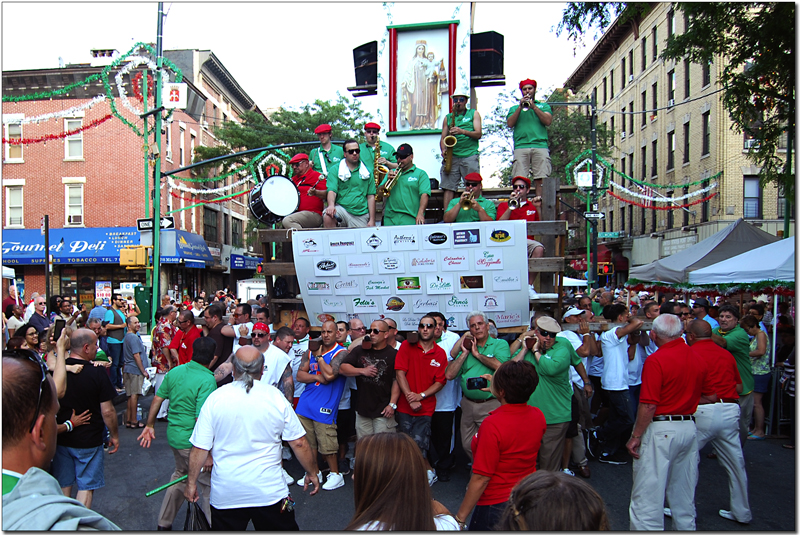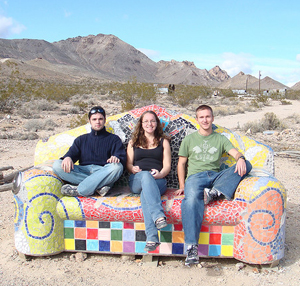The real Little Italy, secrets and saints in the street of the Bronx

By Harvey D. Shapiro
Even weekend thousands of tourists flock to “Little Italy,” in lower Manhattan for cannolis and espresso, but meanwhile the cognoscenti are heading north to what bills itself as “the real Little Italy” in the Bronx. Manhattan’s Little Italy was the area where thousands of Italian immigrants originally settled when they first came to America, but as Italians have prospered, they have moved out, and the burgeoning population of adjacent Chinatown has spilled in. Today, at street level in Little Italy, there are still a dozen restaurants and pastry shops. But the apartments above them are often occupied by Chinese families, and the souvenir shops, with their “Kiss Me I’m Italian” tee-shirts are as likely to be run by immigrants from Tiawan as from Sicily.
 Meanwhile in the North Bronx, the area around Arthur Avenue remains one of New York’s major outposts of Italian immigrant life. While Little Italy was the first stop for the hundreds of thousands of Italian immigrants, many Italians quickly headed for New York’s outer boroughs. The Bensenhurst section of Brooklyn is heavily Italian – and Jewish. And there are Italian outposts in Queens and Staten Island, not to mention the suburbs in New Jersey.
Meanwhile in the North Bronx, the area around Arthur Avenue remains one of New York’s major outposts of Italian immigrant life. While Little Italy was the first stop for the hundreds of thousands of Italian immigrants, many Italians quickly headed for New York’s outer boroughs. The Bensenhurst section of Brooklyn is heavily Italian – and Jewish. And there are Italian outposts in Queens and Staten Island, not to mention the suburbs in New Jersey.
But in the Bronx, substantial numbers of Italians settled in the Morris Park area, and surrounding portions of the north central Bronx. There are no fixed boundaries to the Italian neighborhood. But it’s framed by four major institutions: To the south there is Yankee Stadium (Imagine the excitement when Joe DiMaggio played there.) To the east is the Bronx Zoo and the Bronx Botanical Garden, a pastoral reprise from urban life. And to the west are several major hospitals and Fordham University, a Jesuit institution that has served as the Harvard of Italian Catholic New York.
Arthur Avenue is the high street, the center of the community, with its many shops and restaurants, and Belmont Avenue is another major thoroughfare. When Dion DiMucci formed what would become a celebrated doo-wop music group in the 1950s, his group, Dion and the Belmonts, took its name from that street. And Robert De Niro’s directorial debut, “A Bronx Tale,” took place in the vicinity of Belmont Avenue.
The housing stock in the area is fairly humble: Low rise apartments, two-family houses, and single family houses on small plots of land. But the shopping is world class, and it draws second and third generation Italians as well as other New Yorkers. Mayor Fiorello LaGuardian spearheaded the development of one of the neighborhoods prime attractions, the Arthur Avenue Retail Market. It’s essentially a covered Italian bazaar that brings together under one roof a variety of artisanal food purveyors, from sausage makers and bread bakers to gelato emporiums and fish markets. All this plus crafts shops and purveyors of religious articles.
Meanwhile, the rhythm of life in the area is shaped by Italian events.
● In June, there’s the five day Feast of St. Anthony, which features not only games and food but also the Dancing of the Giglio. It’s preceded by the several days of building the Giglio.
● In September it’s Ferragosto. This ancient tradition recognizes the end of the harvest season and is seen as a time to enjoy the fruits of those labors. The Bronx is hardly an agrarian society, but any excuse for good food.
● At Christmas, there’s the Tree Lighting Ceremony in Ciccarone Park. Participants get cookies and hot chocolate, and they’re invited to bring a Mass card to hang on the tree. The event has been sponsored by D’Bari/Lucia Brothers Funeral Home and the New York City Department of Sanitation Columbia Association – the association of Italians who pick up the garbage. (A century ago in New York seemingly all of the school teachers were Jewish, the police officers were Irish, and the sanitation men were Italian. The Columbia Association –as in Christopher Columbus — still represents a sizable portion of the sanitation department.
● And there are a wealth of Italian-themed events throughout the year. For example, from time to time Our Lady Of Mount Carmel Parish offers Italian Movie Night. And then there’s the week-long Montisi Italian Film Festival offering more than a dozen films, all in Italian with English subtitles. It’s curated in association with the Cineteca Nazionale. In June, last year the Italian Theater Festival in New York offered a one woman show, Solo Anna, marking the 40th anniversary of the death of Anna Magnani. And in October, in honor of Italian Heritage and Culture Month, the Enrico Fermi Cultural Committee presented a program of Italian American Comedy. The Fermi Cultural Committee also offered a Night of Napolitano Music. And, of course, there is the Columbus Day parade in Morris Park, second in size only to the one in Manhattan.
During the 1950s and ‘60s, much of the Bronx was subject to white flight: tens of thousands of second generation European immigrants moved out as blacks and Hispanics moved in. But the Italian areas with their deep family ties remained much more intact.
In Italian immigrant fashion, the neighborhood has a number of two family houses in which the parents live downstairs while a married son or daughter lives upstairs — until the parents pass away, and then the children move downstairs and by then one of their married children moves upstairs. Moreover, there was a television show produced a couple of years ago called “Mama’s Boys” that focused on the substantial number of grown Italian men living with their mothers near Arthur Avenue.
As is the case everywhere in New York, the neighborhood is showing signs of change. Hispanics are moving into nearby communities. The adjacent Allerton area, for example, is nearly 75 percent black and Hispanic. There are still a substantial number of the Italian speakers on the streets – but a growing proportion of them are now Albanians. New immigrants from Albania know they can head to Arthur Avenue and not only find their countrymen, but also a job in one of the many Italian restaurants. The restaurant owners tend to be Italian, but the waiters are often from Albania.
There are other signs that change is in the air. Our Lady of Mount Carmel Parish and School not only has its annual pasta night but last year it also hosted its first “all you can east filet mignon dinner.” The steaks came not with pasta but rather with French fries, ice cream sundaes, and unlimited Coca Cola.
In contrast to other ethnic neighborhoods in New York, however, where assimilation and dilution have proceeded quickly, Arthur Avenue is likely to hold on longer. The newly arrived Albanians are “almost Italians” as one local resident put it. So unlike the original Little Italy, “the real Little Italy” is likely to remain the real thing for a number of ye













Social